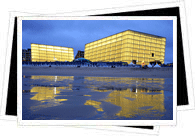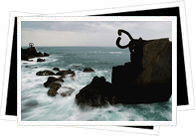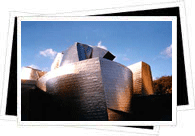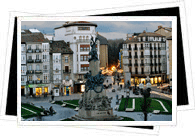 San Sebastián
San Sebastián
San Sebastián - or Donostia, in the Basque language - is an elegant, glittering town sitting around the beautiful bay of La Concha and backed by rolling, wooded hills. San Sebastián has long been a favorite destination, especially to escape Spain's southern summer heat, and the city's role as a place to "summer" has yielded an undeniably fashionable - and pricey - air.
 However, San Sebastián's traditional old quarter, sitting on an eastern ridge with its back to the lush slopes of Monte Urgull, is every bit as cramped, picturesque and lively as a historic quarter is meant to be. The ancient streets of the old part of town is packed with an atmospheric hodgepodge of small bars, cute shops, Baroque façades, Gothic churches, inviting squares and traditional houses. Behind the Plaza de la Constitución (affectionately known as "La Consti"), take the 40 minute hike up the zigzagging paths to the top of Monte Urgull; along with a giant figure of Christ, the natural vantage point offers incredible views out to sea, across the bay and over the city.
However, San Sebastián's traditional old quarter, sitting on an eastern ridge with its back to the lush slopes of Monte Urgull, is every bit as cramped, picturesque and lively as a historic quarter is meant to be. The ancient streets of the old part of town is packed with an atmospheric hodgepodge of small bars, cute shops, Baroque façades, Gothic churches, inviting squares and traditional houses. Behind the Plaza de la Constitución (affectionately known as "La Consti"), take the 40 minute hike up the zigzagging paths to the top of Monte Urgull; along with a giant figure of Christ, the natural vantage point offers incredible views out to sea, across the bay and over the city.
 Bilbao
Bilbao
Having experienced a major Renaissance of its own since the collapse of its traditional industrial base during the 1980's and 1990's, the city of Bilbao is a prosperous, modern city with a booming tourism industry. Bilbao, which stretches along the narrow valley of the Nervión River,
has an open and friendly atmosphere, a nightlife famous for its high-speed bar-hopping (called the "poteo") and a beautiful and diverse cityscape. The attractive old quarter, located on the east bank of the river, encompasses historic theaters, elegant plazas, a Gothic cathedral and a spattering of fantastic museums. Throw in a handful of beaches along the mouth of the estuary, a great tapas culture and the fairly recent addition of architect Frank Gehry's funky Guggenheim Museum, and you'll see why Bilbao is one of Spain's most popular destinations.
 Vitoria
Vitoria
Nestled into the beautiful fertile countryside typical of Green Spain (España Verde) is Vitoria (or Gasteiz in the Basque language), the capital of the province of Alava. Vitoria has long been a prosperous - and at times seriously rich - city of commerce, and it shows in the city's concentration of Renaissance palaces, graceful churches, elegant porticoed plazas and the old trading houses of red brick with wooden beams and balconies. At the center of town is the old cathedral of Santa María, built in the 13th century in the same grayish-golden stone as the rest of the old Gothic quarter.
Hondarribia
Despite having a rather turbulent past, the Basque town of Hondarribia (often called Fuenterrabía in Castilian Spanish) - just across the bay from France - has a remarkably preserved old quarter. Within the partly intact ancient city walls is a charming architectural wonderland, featuring the Gothic Church of Santa María de la Asunción, Renaissance and Baroque noble palaces and the attractive Plaza de Armas, which is dominated by a stone medieval castle (now a parador hotel). Further downhill is the traditional fishing neighborhood known as La Marina- easily the most picturesque part of Hondarribia. La Marina's main street is lined with typical fisherfolk houses with façades painted in bright shades of blue or green and wooden balconies decorated with overflowing flower boxes. Finally, venture up to the Higuer lighthouse for sweeping views of the coast.
Getaria
Getaria is an absolutely breathtaking coastal village along the coast of the Basque province of Guipúzcoa. Once a village known for its prosperous whale-hunting (the town's medieval coat of arms rather graphically depicts a harpooned whale), Getaria maintains the historical and traditional air of its seafaring heritage. Stroll leisurely along cobbled streets boasting quaint medieval houses, somber Gothic churches, ancient hermitages and much more. To recharge, pop into any of the handful of restaurants bordering the harbor to sample the fresh catch of the day along with a glass of the famous local txakoli wine.
Guernica
The small town of Guernica, memorably immortalized by Picasso in his striking black and white painting, is much more of a pilgrimage visit than a tourist stop. Once the heart of fervent Basque regionalism and pride, its symbolic importance was one of the major reasons that it was targeted for first ever bombing raid on a civilian center. In 1937, Spain was in the throes of the Spanish Civil War. Using planes lent to him by Hitler, the soon-to-be Spanish dictator and ultra-nationalist Francisco Franco green-lighted the saturation bombing raid. In four hours, the town's center was almost entirely destroyed and more than 1,600 people were killed.
Picasso's dramatic masterpiece is one of the gems in Madrid's Museo Centro de Arte Reina Sofía, but Guernica's own museum dedicated to one of the most violent events of spanish history showcases a fantastic collection of Picasso's Guernica sketches.